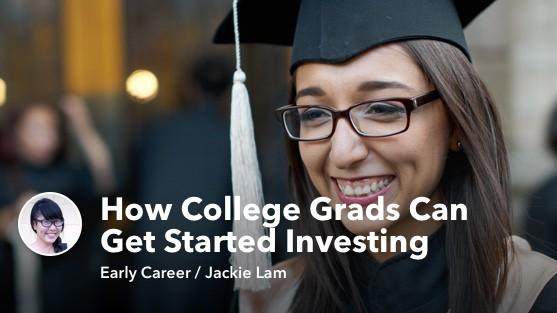How College Grads Can Get Started Investing

[ad_1]
If you’ve just graduated college—first off, congrats! And as you’re creating a massive “next steps” to-do list, that might include landing your first grown-up job, moving to new stomping grounds, or creating a budget, you’ll want to add one thing: investing.
We get it. While retirement might seem like aeons away, here’s the thing: The sooner you squirreling your beans away for retirement, the better.
In this article, we’ll go over a few pointers on how to get started investing if you’re a fresh college grad:
Start Small and Start Now
Getting a jump on investing what you’re young benefits you in several ways. First, time is on your side. And through compound interest, your money will grow quicker over time, explains Larry Ludwig, founder of Investor Junkie.
Let’s say you invest the max you can into a Roth IRA, which is $5,500, each year for 10 years, explains Charlie Horonzy, CFP®, CPA of Focused Up Financial. So, from when you’re 21 to 31 years old, you invest $5,500 a year. If you earn an 8% return on your money, by the time you’re 65, you’ll have earned nearly $1.2 million!
Now let’s say you wait five years and then start investing at age 27. And if you invest $5,500 each year for 10 years, and still earn the same rate of return: 8%. You’ll only have $800,000 at age 65. “While $800,000 is a lot of money, but it’s over $375,000 less than if you started investing when you were 22,” points out Horonzy.
Besides the power of compound interest, investing now helps you get into the habit of investing. As it’s a key part of wealth-building, you’ll want to get comfortable with the idea of saving for the long-term, Plus, you’ll earn to deal with the inevitable ups and downs that come with investing in the stock market.
Start Small
You don’t even need a lot to get started. Here are a few simple ways:
Micro Investing: These days you can invest via a micro-investing app such as Stash or Acorns. All you’ll need is $5 to open an account. Note that Stash charges $1 for accounts with balances up to $5,000. If you’re opening an IRA, it’s $2 for account balances up to $5,000.
Like Stash, Acorns’ fee is $1 for accounts with balances up to $5,000. If you have more than $5,000 sitting in your account, you’ll be charged a percentage. What’s pretty cool is that if you’re still a college student, Acorns is free for four years. You’ll just need to provide an .edu email address.
ETFs. Another option is to invest in ETFs, or exchange-traded funds. ETFs are a type of security that tracks a basket of assets, index, commodity, or bonds. Because you’re investing in a bunch of stocks versus a single one, you’ll enjoy the benefits of diversification.
Plus, ETFs tend to have lower expense ratios, which is a definite bonus if you don’t have a lot of money to invest with. Some brokerage firms even offer no transaction fees for ETFs.
See Where You Can Cut Back
So you’re probably scratching your head, wondering where you’ll find that extra dough to invest with. It’s actually not as hard as you think. First, track your spending to see where you money is going. Then see where you can cut back so you can afford to invest, say, $50 or $100 a month.
You may be surprised to see just how much you spent going out with your friends, or on coffee or trips to the barcade, explains Horozny. “All those drinks add up,” says Horozny. “After you start tracking your expenses, it gets much easier to understand just how you’re spending money.”
It’s only then that you’ll get clued in on ways you can cut back so you can invest. Maybe it’s brown bagging it to lunch a few days a week. Or curbing the impulse to spend a few buckaroos on a flash online sale of your favorite store. And if you’re making the effort to save that bit of money, make sure it goes directly toward your efforts to invest.
Take Advantage of Employer-Sponsored Retirement Plans
Does your current workplace offer an employer-sponsored retirement plan, such as a 401(k) or 403(b)? If so, that’s a great way to get your feet wet with investing. All you need to do is enroll and decide the percentage of your salary you want to contribute. And be sure to and take advantage of any matching contributions. Otherwise, that’s money you’re leaving on the table.
Strike a Balance Between Paying Off Debt and Investing
If you’ve just graduated college, we feel you. But you don’t want to wait 10-plus years to pay off your student loans, or until you’ve made a major dent in your credit card debt to start investing.
Instead, strike a financial balance. You can pay down your debt and invest, points out Robert Farrington of The College Investor. Come up with a plan to pay off student loans and credit card debt and invest a little each month. Even if it’s just a hundred bucks a month, it’ll help you get into the habit of growing your money. And as you gradually knock off debt, you can funnel more money into building your investments.
Look Closely at Fees
If you don’t examine fees, it could cost you. “With everything else you buy, you shop around for the best possible price,” says Ludwig. “Why not do it with the investment services you use?” That’s right, even a fraction of a percentage could eat up into your investments. So know the total fees you are paying with any investment service you use, points out Ludwig. This may include expense ratios, annual fees, front- and back-load fees, investment management fees, and transaction fees.
“Look for brokers that charge no monthly or annual fees, and have low expense ratio funds,” says Farrington. “Many large brokers have no minimum IRAs and other accounts you can take advantage of.” Some of the fees aren’t as obvious to the customer, adds Ludwig. So do your homework and ask questions before investing.
By keeping investing top of mind right out of college, you’ll be laying the groundwork for financial wellness. After all, drumming up ways to grow your money while you’re still young is an essential part of adulting. And no doubt, fast forward 20 years, your future self will be grateful.
Jackie Lam is a personal finance writer. Her work has appeared in Investopedia, Magnify Money and The Bold Italic, and she’s been featured in Money, Kiplinger, Forbes and Woman’s Day. She runs Cheapsters.org, a blog to help freelancers and artists with their money, and to balance their passion projects and careers.
This document/information does not constitute, and should not be considered a substitute for, legal or financial advice. Each financial situation is different, the advice provided is intended to be general. Please contact your financial or legal advisors for information specific to your situation.
[ad_2]
Source link


